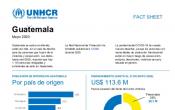Panama Multi-Country Office
UNHCR's Office in Panama covers operations in Belize (since 2018), Cuba, El Salvador, Guatemala (until 2019), Honduras (until 2019) and Nicaragua.
Operation: Panama Multi-Country Office
Location
{"longitude":-80,"latitude":8,"zoom_level":5,"iso_codes":"'BLZ','CUB','GTM','HND','NIC','PAN','SLV'"}
By clicking on the icons on the map, additional information is displayed.
The boundaries and names shown and the designations used on this map do not imply official endorsement or acceptance by the United Nations.
Key figures Panama
| 2020 planning figures | |
| 80% | of targeted households will have their basic needs met with multi-purpose cash grants or voucher in the region |
| 80% | of people of concern will receive legal assistance and support |
| 75% | of people of concern will be registered on an individual basis |
| 60% | of targeted people of concern will be self-employed and provided with livelihoods opportunities |
| 20,000 | people of concern will be provided with accommodation in reception and transit centers |
| 2017 year-end figures | |
| 5,970 | individuals received material and psychosocial support |
| 3,760 | people of concern received legal support |
| 1,320 | households received multipurpose cash grants |
| 1,220 | partner, government and UNHCR staff were trained on SGBV prevention and response and/or child protection |
| 370 | resettlement departures were arranged |
Latest Updates and Related Links
People of Concern
21%
Increase in
2019
2019
| 2019 | 586,131 |
| 2018 | 484,586 |
| 2017 | 375,326 |

[["Refugees",3693],["Asylum-seekers",20772],["IDPs",318590],["Others of concern",127307],["Venezuelans displaced abroad",115769]]
Loading ...
Panama Multi-Country Office
< Back
2019
{"categories":[2015,2016,2017,2018,2019,2020],"budget":[8.225381364,16.64769407,22.672193686,27.00111865,63.738570732,43.803630659999996],"expenditure":[4.39118839,9.23860236,12.70058696,19.026620809999997,23.54673411,null]}
{"categories":[2015,2016,2017,2018,2019,2020],"p1":[8.225381364,16.64769407,22.672193686,27.00111865,63.738570732,25.16435089],"p2":[null,null,null,null,null,null],"p3":[null,null,null,null,null,null],"p4":[null,null,null,null,null,18.639279769999998]}
{"categories":[2015,2016,2017,2018,2019,2020],"p1":[4.39118839,9.23860236,12.70058696,19.026620809999997,23.54673411,null],"p2":[null,null,null,null,null,null],"p3":[null,null,null,null,null,null],"p4":[null,null,null,null,null,null]}
Loading ...
CHOOSE A YEAR
- 2015
- 2016
- 2017
- 2018
- 2019
- 2020
Operational Environment
UNHCR’s Regional Office in Panama ensures the overall coordination of the Regional Protection and Solutions Strategy for the North of Central America (NCA) situation and supports the implementation of the regional application of the CRRF. UNHCR now has fully-fledged national offices in Belize, El Salvador, Honduras and Guatemala and maintains a small presence in Cuba for protection activities. The Regional Office in Panama also has oversight over offices in Costa Rica and covers also Nicaragua where it has no operational presence.The growing trend of forced displacement from and within El Salvador, Guatemala and Honduras continues unabated, with almost 310,000 refugees and asylum-seekers from the NCA registered by mid-2018, an increase of 54 per cent compared to the same period last year and a tenfold increase over the past five years.
While displacement in and from the NCA is multifaceted and has multiple causes, violence and insecurity continues to be a major factor compelling people to move. Traditionally, people from the NCA countries seek international protection in Canada and the United States of America. However, in recent years, UNHCR has witnessed a significant increase in the number of asylum-seekers from the NCA in Belize, Costa Rica, Mexico and Panama. Guatemala is also increasingly being perceived by people of concern as a country of asylum, not only of transit. The recent crises in Venezuela and Nicaragua have put additional pressure on national asylum systems in the hosting countries.
In 2019, UNHCR will continue to reinforce its protection responses in the region, strengthening asylum systems, reception conditions and immediate humanitarian assistance through cash-based interventions. At the same time, livelihood initiatives will be stepped up in asylum countries to support local integration and peaceful coexistence with host communities.
Data on internal displacement due to violence in the NCA remains fragmented, although El Salvador has recently released a study on the topic and Honduras is in the process of updating the 2014 profiling exercise.
In 2019, the CRRF approach will be rolled out further in the region, with a view to forge new alliances with regional development actors and the private-sector. The six participating States (Belize, Costa Rica, Guatemala, Honduras, Mexico and Panama) will be supported to comply with their commitment to further consolidate existing regional collaboration by strengthening responsibility-sharing and enhancing protection of asylum-seekers, refugees and IDPs.
Key Priorities
In 2019, UNHCR will focus on:- Building strong asylum systems in destination countries;
- Strengthening mechanisms that can respond to urgent protection risks faced by IDPs and other people affected by violence in countries of origin;
- Identifying and protecting deportees with protection needs;
- Finding durable solutions for people of concern, including local integration in destination countries, resettlement through the Protection Transfer Arrangement (PTA) programme, or cooperation with development actors to address root causes that will allow for voluntary return;
- Ensuring safe transit along the main migration routes by establishing protection networks and providing humanitarian assistance, with a special focus on the most vulnerable (women, children, LGBTI people).
Funding shortfalls for the regional protection response could result in greater displacement, increased risks for people of concern who have to flee, and who might be forced to take more insecure routes and become subject of exploitation, SGBV, trafficking, and forced recruitment.




















